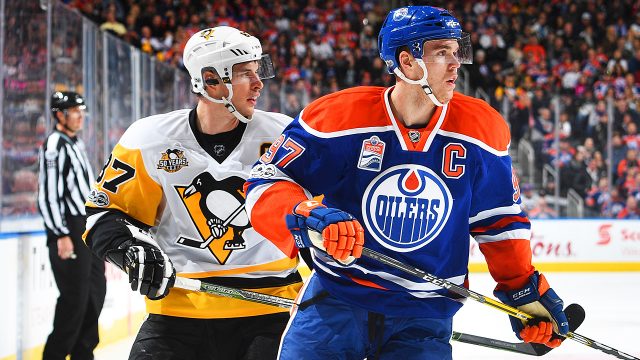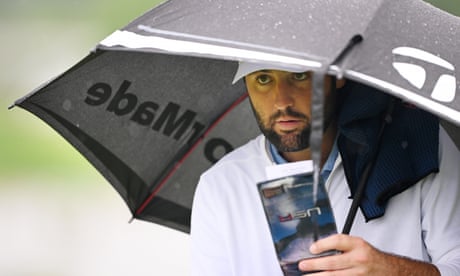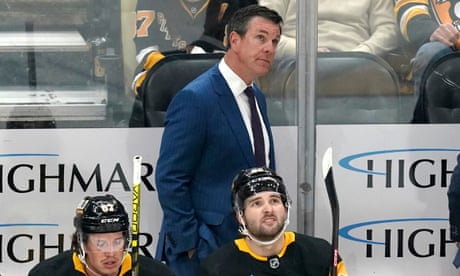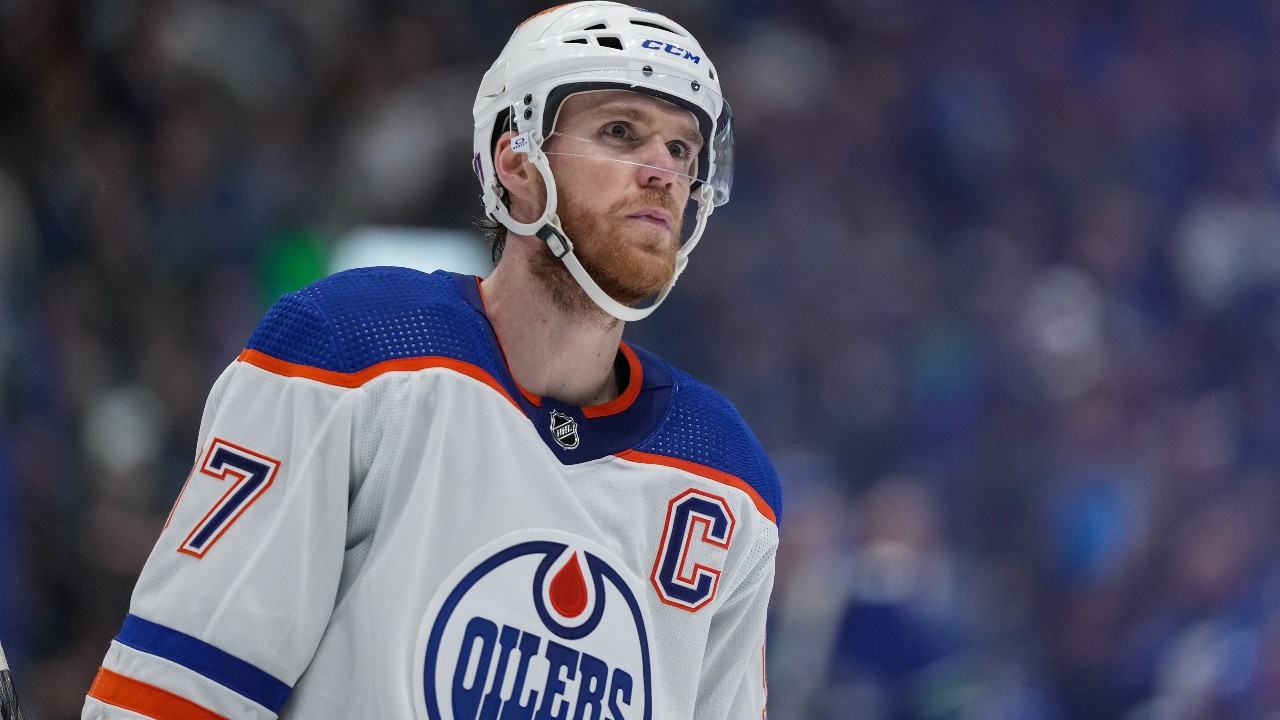
The futures of some NHL teams will be determined this Friday night when the first part of the 2020 NHL Draft Lottery takes place.
The second part of it, well, may not happen at all. That’s because this year’s version of the lottery has been set up in a unique way to involve 15 teams before eight of them have even had their seasons come to an end. We will know what the top three will look like after Friday’s draw, but we may not know which teams specifically will be picking there.
More on that a bit later.
Though this year’s change is likely a one-off adjustment in response to the COVID-19 season interruption, the lottery has come in a few different forms since it was first instituted in 1995. Where at first it was much more likely for a last place team to hang on to the No. 1 overall spot, nowadays that team could slide all the way to No. 4. It’s become a much more exciting and made for TV event than it was in the early days.
As we look forward to some action through the lottery this Friday night (which you can watch on Sportsnet starting at 8 p.m. ET/ 5 p.m. PT) here is a brief look at the history of the NHL Draft Lottery and how it’s changed over the years.
1995 – 2012: The start of the entry draft lottery
While NHL drafts have been going on since the 1960s, the yearly draft lottery as we generally know it didn’t begin until the mid-’90s.
In 1995 the NHL instituted the lottery for the first time in an attempt to dissuade teams from tanking for the top pick. Prior to this, the draft order was determined by regular season finish, with the first round going in inverse order of the standings.
So it was more exciting than before because now there was theatre around the top of the draft, but movement was still limited. Teams couldn’t move up more than four spots in the draft order, so the only teams eligible to “win” the first overall pick were the bottom five. Likewise, no team could move down more than one spot from their regular season finish.
And in fact, the Los Angeles Kings won that first lottery with the seventh-best odds, so they only moved up to pick No. 3 where they got Aki Berg. Had the lottery rules granted the winner with the first overall pick automatically, the Kings could have gotten Bryan Berard, while the last-place Senators would have fallen to No. 2 and likely ended up with Wade Redden (who was traded to Ottawa before his rookie season anyway).
| YEAR | WORST TEAM | LOTTERY WINNER (ODDS RANKING) | NO. 1 PICK MADE BY | FIRST OVERALL PICK |
|---|---|---|---|---|
| 1995 | Ottawa | Los Angeles (7th) | Ottawa | Bryan Berard |
| 1996 | Ottawa | Ottawa (1st) | Ottawa | Chris Phillips |
| 1997 | Boston | Boston (1st) | Boston | Joe Thornton |
| 1998 | Tampa Bay | San Jose (2nd) | Tampa Bay | Vincent Lecavalier |
| 1999 | Tampa Bay | Chicago (8th) | Atlanta | Patrik Stefan |
| 2000 | Atlanta | NY Islanders (5th) | NY Islanders | Rick DiPietro |
| 2001 | NY Islanders | Atlanta (3rd) | Atlanta | Ilya Kovalchuk |
| 2002 | Atlanta | Florida (3rd) | Columbus | Rick Nash |
| 2003 | Carolina | Florida (4th) | Pittsburgh | Marc-Andre Fleury |
| 2004 | Pittsburgh | Washington (3rd) | Washington | Alex Ovechkin |
| 2005 | Pittsburgh | Pittsburgh | Sidney Crosby | |
| 2006 | St. Louis | St. Louis (1st) | St. Louis | Erik Johnson |
| 2007 | Philadelphia | Chicago (5th) | Chicago | Patrick Kane |
| 2008 | Tampa Bay | Tampa Bay (1st) | Tampa Bay | Steven Stamkos |
| 2009 | NY Islanders | NY Islanders (1st) | NY Islanders | John Tavares |
| 2010 | Edmonton | Edmonton (1st) | Edmonton | Taylor Hall |
| 2011 | Edmonton | New Jersey (8th) | Edmonton | Ryan Nugent-Hopkins |
| 2012 | Columbus | Edmonton (2nd) | Edmonton | Nail Yakupov |
A few other interesting notes from these years…
1998: The Sharks made the playoffs this season, but held Florida’s first-round pick and won the lottery with it. However, the Sharks made a trade deadline deal with the Lightning which allowed Tampa Bay the option to swap first-round picks. After losing the lottery, the Lightning went through with the swap and picked Vincent Lecavalier first overall anyway.
1999: This, of course, was the Sedin draft year where then-Canucks GM Brian Burke worked some trade magic. The Lightning, holders of the first overall pick after the lottery, traded it to Vancouver, who worked a couple of other deals that ultimately landed them at picks two and three, with Atlanta holding No. 1. The Thrashers took Patrik Stefan, the Canucks took the twins and the rest is history.
2002: Florida won the lottery and the right to choose first overall, but dealt the pick to Columbus and moved down to No. 3. The Blue Jackets took Rick Nash while the Panthers got the guy they wanted anyway, Jay Bouwmeester, at third overall. As part of this swap, the Panthers also had the option to swap first-rounders with Columbus in 2003, but that didn’t happen because…
2003: The Panthers won the lottery again and moved from fourth overall to first. But, for the second year in a row, they traded the first overall pick, this time to Pittsburgh. The Penguins took Marc-Andre Fleury, while Florida selected Nathan Horton third overall (the pick acquired from Pittsburgh in the swap) — which made sense since Florida had Roberto Luongo at the time. But can you imagine the same team trading the first overall pick in back-to-back seasons today?
2005: In case you forgot, there was no “worst team” in 2005 because there was no season at all. In this draft lottery teams were given one, two or three “balls” based on team success from the previous three seasons. The Penguins were one of the teams with three balls, thus giving them some of the best odds, and they came away with the best player of a generation.
2013 – 2014: Everyone in the lottery has a shot at No. 1
The first major change made to the lottery turned it into a much better “made for TV” event. Now, rather than being limited in how far a team could move up in the order, the winner of the draft lottery would get the first overall pick and every other team would move down one slot.
It was now a much more thrilling event. Technically, a team could miss the playoffs by a single point and not be all that bad, then win the lottery and have a shot at acquiring a franchise-altering player for free. This specific format was short lived, but added another layer of intrigue to the proceedings.
In 2013, the Florida Panthers finished last in the league but didn’t end up with the first overall pick (no, they didn’t trade it this time). The second-last place Colorado Avalanche won the lottery to leapfrog Florida — the Avalanche took Nathan MacKinnon first overall and the Panthers “settled” for Aleksander Barkov second overall.
In 2014 the second-last place team in the league won the lottery again. This time it was Florida with some good lottery luck, as they moved ahead of the Buffalo Sabres. The Panthers took Aaron Ekblad first overall and the Sabres got Sam Reinhart second (Leon Draisaitl went third to Edmonton).
2015: The odds of winning get a little longer for the worst teams
To discourage tanking even more, the NHL changed its lottery odds in 2015 to make it a little harder for the bottom-four teams to win it.
Prior to this change, the worst team in the league had a 25 per cent chance to win the lottery and the next three teams were at 18.8 per cent, 14.2 per cent and 10.7 per cent. But in 2015 those chances for the top four teams changed to 20 per cent, 13.5 per cent, 11.5 per cent and 9.5 per cent. At the same time, the odds for every other team in the lottery improved somewhat. For example, the eighth-worst team’s odds improved from 3.6 per cent in prior seasons to six per cent in 2015. The team with the longest odds prior to 2015 had a 0.5 per cent chance of winning, but that doubled to one per cent in 2015.
This format for the lottery lasted just one season, but the new odds didn’t really come into play. Edmonton, the third-worst team that season, won the lottery with a smaller chance than it would have a year earlier and came away with Connor McDavid.
2016: The top three picks are up for grabs at the lottery
To further dissuade tanking — and, heck, make the event that much more entertaining — the NHL changed its lottery again to put even more on the line. Odds remained the same, but rather than having a single draw to determine first overall, multiple draws took place to determine the top three picks in the draft.
In this new format the last-place Toronto Maple Leafs held on to the first overall pick with their 20 per cent chances, but there was some interesting movement behind them. The Winnipeg Jets, with just a 7.8 per cent chance, wound up with the second overall pick to take Patrik Laine, while fourth-last Columbus wound up moving into the three position where they took Pierre-Luc Dubois.
Had the lottery format not changed this year, picks two and three behind Toronto would have gone to Edmonton and Vancouver.
2017: Expansion Vegas gets into the lottery
There were no changes to the lottery format in 2017, but the league’s brand new 31st team was involved before playing a game. The Vegas Golden Knights were given the same draft lottery odds as the third-worst team in Arizona — but they ended up falling as far as they could have, all the way to sixth overall.
That’s because this lottery brought all kinds of unpredictability. None of the top three selections went to a team in the top three. New Jersey moved from fourth up to first, Philadelphia went from 12th to the second overall pick (with a 2.4 per cent chance) and Dallas moved from eighth to third (with a 6.4 per cent chance). Nico Hischier, Nolan Patrick and Miro Heiskanen were taken with these picks, followed by Cale Makar to Colorado and Elias Pettersson to Vancouver.
2020: A unique lottery during the pandemic
How do you conduct a lottery when,
a) a full regular season hasn’t been completed and
b) the league returns with a 24-team playoff that includes a number of teams that would have otherwise been in the lottery?
The league could have decided to have just a seven-team lottery for those top three picks, but chose to involve 15 teams as always. The difference this year is that the lottery could possibly be done in two phases, the first on June 26 and the potential second after the best-of-five play-in round this summer. When that first lottery happens the seven non-playoff teams will be involved, plus eight “placeholder” teams — so it’s possible we’ll walk out of Friday’s draw not knowing who holds a top-three pick.
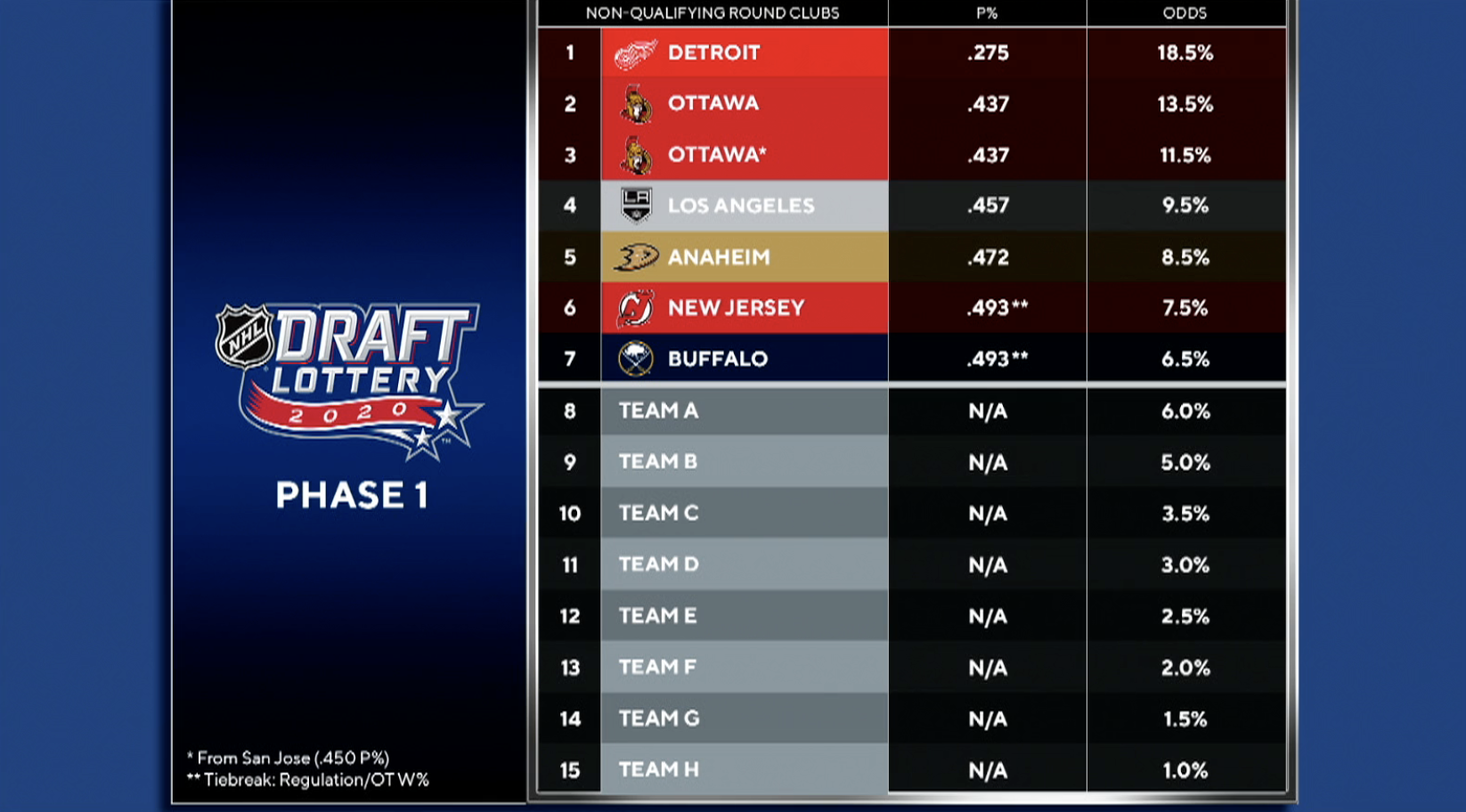
“The seven clubs that did not resume play and the eight qualifying round clubs that do not advance into the playoffs will enter the draft lottery,” Gary Bettman said. “At the time of the first phase draws we won’t know which eight teams won’t advance from the qualifying round, so we have designated temporary placeholders with the odds that the collective group would have had.”
If each of the top three draft slots are won by teams that aren’t returning to play this summer, there will be no second phase of the lottery. However, if even one of the placeholders claims a top three position, then a second lottery will be held after eight teams are eliminated from the play-in round to determine who moves up into those positions.
In this second lottery, only the eight teams eliminated in the qualifying round will be involved and each of them will have the same odds to move into the top three (12.5 per cent). If more than one placeholder wins a top three spot in the first lottery, further draws will be made. After both of these lotteries are done, the rest of the first round will be slotted in reverse order of regular season points percentage.


